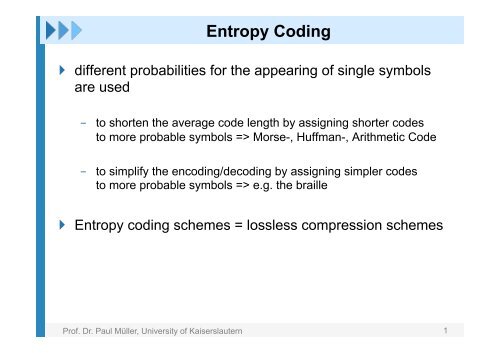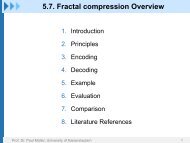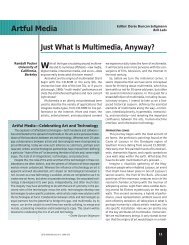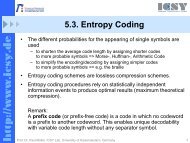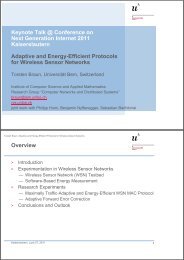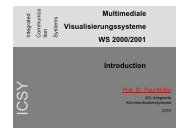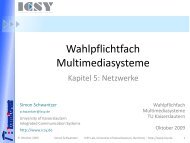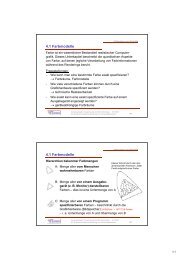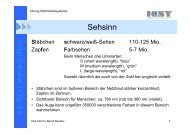05-compression-02-entropy coding.pptx - ICSY
05-compression-02-entropy coding.pptx - ICSY
05-compression-02-entropy coding.pptx - ICSY
You also want an ePaper? Increase the reach of your titles
YUMPU automatically turns print PDFs into web optimized ePapers that Google loves.
Entropy Coding<br />
} different probabilities for the appearing of single symbols<br />
are used<br />
- to shorten the average code length by assigning shorter codes<br />
to more probable symbols => Morse-, Huffman-, Arithmetic Code<br />
- to simplify the en<strong>coding</strong>/de<strong>coding</strong> by assigning simpler codes<br />
to more probable symbols => e.g. the braille<br />
} Entropy <strong>coding</strong> schemes = lossless <strong>compression</strong> schemes<br />
Prof. Dr. Paul Müller, University of Kaiserslautern<br />
1
Entropy Coding<br />
} Entropy <strong>coding</strong> procedures rely on statistically<br />
independent information events to produce optimal results<br />
(maximum theoretical <strong>compression</strong>)<br />
} Remark<br />
A prefix code (or prefix-free code) is a code in which no<br />
codeword is a prefix to another codeword. This enables<br />
unique decodability with variable code length without any<br />
separator symbol<br />
Prof. Dr. Paul Müller, University of Kaiserslautern<br />
2
The Braille<br />
Prof. Dr. Paul Müller, University of Kaiserslautern<br />
3
Run-length Coding<br />
} repetitive sequence suppression: run-length <strong>coding</strong><br />
} compresses: same successive symbols<br />
} Example:<br />
- "x" marks the beginning of a coded sequence<br />
- special <strong>coding</strong> is required to code "x" as a symbol, here "xx" is<br />
used.<br />
- Zero suppression is a special form of run-length <strong>coding</strong><br />
Prof. Dr. Paul Müller, University of Kaiserslautern<br />
4
Morse Code<br />
Example: Letter statistic compared to Morse Code<br />
Letter<br />
probability<br />
German<br />
probability<br />
English<br />
Morse Code<br />
e 16.65% 12.41% .<br />
n 10.36% 6.41% _ .<br />
i 8.14% 6.46% . .<br />
t 5.53% 8.90% _<br />
a 5.15% 8.09% . _<br />
o 2.25% 8.13% _ _ _<br />
x 0.03% 0.20% _ . . _<br />
y 0.03% 2.14% _ . _ _<br />
Prof. Dr. Paul Müller, University of Kaiserslautern<br />
5
Morse Code<br />
} The idea of using fewer bits to represent symbols that<br />
occur more often is used in Morse code<br />
- codewords for letters occuring more frequently are shorter than<br />
for letters that occur less frequently<br />
- example: the codeword for "E" is •, while the codeword for "Z" is –<br />
– • •<br />
} variable code length & nonprefix code<br />
à needs separator symbol for unique decodability<br />
- Example: “.._…” à eeteee, ini, ...<br />
Prof. Dr. Paul Müller, University of Kaiserslautern<br />
6
Huffman Coding<br />
} Idea: Use short bit patterns for frequently used symbols<br />
- sort all symbols by probability<br />
- get the two symbols with the lowest probability<br />
- remove them from the list and insert a "parent symbol" to the<br />
sorted list where the probability is the sum of both symbols<br />
- if there are at least two elements left, continue with step 2<br />
- assign 0 and 1 to the branches of the tree<br />
} Example: 1380 bits are used for "regular <strong>coding</strong>"<br />
Symbol Count regular<br />
E 135 000<br />
A 120 001<br />
D 110 010<br />
B 50 011<br />
C 45 100<br />
Prof. Dr. Paul Müller, University of Kaiserslautern<br />
7
Huffman Coding<br />
Symbol Count<br />
E 135<br />
A 120<br />
D 110<br />
P1 95<br />
Prof. Dr. Paul Müller, University of Kaiserslautern<br />
8
Huffman Coding<br />
Symbol Count<br />
P2 2<strong>05</strong><br />
E 135<br />
A 120<br />
Prof. Dr. Paul Müller, University of Kaiserslautern<br />
9
Huffman Coding<br />
Symbol Count<br />
P3 255<br />
P2 2<strong>05</strong><br />
Prof. Dr. Paul Müller, University of Kaiserslautern<br />
10
Huffman Coding<br />
Symbol Count Huffman p i<br />
E 135 00 0,294<br />
A 120 01 0,261<br />
D 110 10 0,239<br />
B 50 110 0,109<br />
C 45 111 0,098<br />
à 1015 bits are used for huffman <strong>coding</strong><br />
Prof. Dr. Paul Müller, University of Kaiserslautern<br />
11
Huffman Coding<br />
Symbol Count Huffman p i<br />
E 135 00 0,2935<br />
A 120 01 0,2609<br />
D 110 10 0,2391<br />
B 50 110 0,1087<br />
C 45 111 0,0978<br />
} Entropy:<br />
=> H ≈ 2,1944<br />
} Average code length:<br />
l = 2*p 1 +2*p 2 +2*p 3 +3*p 4 +3*p 5 ≈ 2,2065<br />
Prof. Dr. Paul Müller, University of Kaiserslautern<br />
12
Adaptive Huffman Coding<br />
} Problem<br />
- previous algorithm requires statistical knowledge (the probability<br />
distribution), often not available (e.g. live audio, video)<br />
- even when statistical knowledge is available, it could be too much<br />
overhead to send it<br />
} Solution<br />
- use of adaptive algorithms<br />
- here: Adaptive Huffman Coding<br />
- keeps up estimating the required probability distribution from<br />
previously encoded/decoded symbols by an update procedure<br />
Prof. Dr. Paul Müller, University of Kaiserslautern<br />
13
Adaptive Huffman Coding<br />
} having a look at the implementation:<br />
} encoder and decoder use exactly the same initialization<br />
and update_model routines<br />
} update_model does two things:<br />
- increment the count<br />
- update the resulting Huffman tree<br />
• during the updates, the Huffman tree will be maintained its sibling<br />
property, i.e. the nodes are arranged in order of increasing weights<br />
• when swapping is necessary, the farthest node with weight W is<br />
swapped with the node whose weight has just been increased to W+1<br />
(If the node with the weight W has a sub-tree beneath it, then the subtree<br />
will go with it)<br />
Prof. Dr. Paul Müller, University of Kaiserslautern<br />
14
Adaptive Huffman Coding<br />
} Example n-th Huffman tree<br />
} resulting code for A: 000<br />
Prof. Dr. Paul Müller, University of Kaiserslautern<br />
15
Adaptive Huffman Coding<br />
} n+2-th Huffman tree<br />
- A was incremented twice node<br />
- A and D swapped<br />
} new code for A: 011<br />
Prof. Dr. Paul Müller, University of Kaiserslautern<br />
16
Adaptive Huffman Coding<br />
} A was incremented twice<br />
} 4th (A) and 5th node have to swap<br />
Prof. Dr. Paul Müller, University of Kaiserslautern<br />
17
Adaptive Huffman Coding<br />
} resulting tree after 1st swap<br />
} 8th (E) and 7th node have to swap<br />
Prof. Dr. Paul Müller, University of Kaiserslautern<br />
18
Adaptive Huffman Coding<br />
} n+4-th Huffman tree<br />
} new code for A: 10<br />
Prof. Dr. Paul Müller, University of Kaiserslautern<br />
19
Huffman Coding Evaluation<br />
} Advantages<br />
- the algorithm is simple<br />
- Huffman Coding is optimal according to information theory when<br />
the probability of each input symbol is a negative power of two<br />
- if p max is the largest probability in the probability model, then the<br />
upper bound is H + p max + ld[(2 ld e)/e] = H + p max + 0,086.<br />
This is tighter than<br />
Prof. Dr. Paul Müller, University of Kaiserslautern<br />
20
Huffman Coding Evaluation<br />
} Limitations<br />
- Huffman is designed to code single characters only. Therefore at<br />
least one bit is required per character, e.g. a word of 8 characters<br />
requires at least an 8 bit code<br />
- Not suitable for strings of different length or changing probabilities<br />
for characters in a different context, respectively<br />
Examples for both interpretations of that problem:<br />
• Huffman <strong>coding</strong> does not support different probabilities for: "c" "h" "s"<br />
and "sch”<br />
Prof. Dr. Paul Müller, University of Kaiserslautern<br />
21
Huffman Coding Evaluation<br />
} Limitations (cont.)<br />
• For a usual german text p("e") > p("h") is valid, but if the preceding<br />
characters have been "sc" then p("h") > p("e") is valid<br />
- (non-satisfying) solutions for both scenarios:<br />
• Solution: Use a special <strong>coding</strong> where "sch" is one character only.<br />
But this requires knowledge about frequent character combinations in<br />
advance.<br />
• Solution: use different huffman codes with respect to the context.<br />
But this leads to large code tables which must be appended to the<br />
coded data<br />
Prof. Dr. Paul Müller, University of Kaiserslautern<br />
22
Arithmetic Coding<br />
} arithmetic <strong>coding</strong> generates codes that are optimal<br />
according to information theory<br />
- supports average code word length smaller than 1<br />
- supports strings of different length<br />
} probability model is separated from en<strong>coding</strong><br />
operation<br />
- probability model:<br />
• en<strong>coding</strong> strings and not single characters<br />
• assign "codeword" to each possible string<br />
• codeword consists of a half open subinterval of the interval [0,1]<br />
• subintervals for different strings do not intersect<br />
Prof. Dr. Paul Müller, University of Kaiserslautern<br />
23
Arithmetic Coding<br />
} probability model is separated from en<strong>coding</strong><br />
operation (cont.)<br />
- En<strong>coding</strong>:<br />
• given subinterval can be uniquely identified by any value of that<br />
interval<br />
• Use the value with the shortest non-ambiguous binary representation<br />
to identify the subinterval<br />
} In practice, the subinterval is refined incrementally<br />
using the probabilities of the individual events.<br />
- If strings of different length are used, extra information is needed<br />
to detect the end of a string<br />
Prof. Dr. Paul Müller, University of Kaiserslautern<br />
24
Arithmetic Coding<br />
} Example I<br />
- Four characters a, b, c, d with probabilities p(a)=0.4, p(b)=0.2, p<br />
(c)=0.1, p(d)=0.3. Codeword assignment for string "abcd":<br />
à codeword (subinterval): [0.21360, 0.21600)<br />
Prof. Dr. Paul Müller, University of Kaiserslautern<br />
25
Arithmetic Coding<br />
} Example I (cont.)<br />
- En<strong>coding</strong>:<br />
any value within the subinterval [0.21360, 0.21600) will now be<br />
a well-defined identifier of the string “abcd”<br />
- "0.00110111" will be the shortest binary representation of the<br />
subinterval<br />
Prof. Dr. Paul Müller, University of Kaiserslautern<br />
26
Arithmetic Coding<br />
} Example I (cont.)<br />
- De<strong>coding</strong>: "0.00110111" resp. 0.21484375<br />
- receiver can rebuild the subinterval development but:<br />
code is member of any further subinterval of [0.21360, 0.21600)<br />
=> extra symbol necessary to mark end of string<br />
Prof. Dr. Paul Müller, University of Kaiserslautern<br />
27
Arithmetic Coding<br />
} Example II<br />
- Propabilties:<br />
Prof. Dr. Paul Müller, University of Kaiserslautern<br />
28
Arithmetic Coding<br />
Example II (cont.)<br />
} Termination rules:<br />
- "a" and "!" are termination symbols<br />
- Strings starting with "b" have a length of max 4.<br />
} Decode: 10010001010<br />
Bit<br />
1 -<br />
0 b<br />
0 -<br />
1 b<br />
0 a<br />
Output<br />
0 -<br />
0 a<br />
1 -<br />
0 b<br />
1 bb<br />
0 b<br />
Prof. Dr. Paul Müller, University of Kaiserslautern<br />
29
Arithmetic Coding<br />
} Remarks<br />
- The more characters a string has, the better is the result<br />
concerning average code word length<br />
- Implementing arithmetic <strong>coding</strong> is more complex than huffman<br />
<strong>coding</strong><br />
- Alphabets with k characters and strings with length m destroy the<br />
idea of huffman <strong>coding</strong> for increasing m (codebook with size k^m).<br />
Arithmetic <strong>coding</strong> can be adapted.<br />
Prof. Dr. Paul Müller, University of Kaiserslautern<br />
30
Arithmetic Coding<br />
} Remarks<br />
- if the alphabet is small and the probabilities are highly unbalanced<br />
arithmetic <strong>coding</strong> is superior to huffman <strong>coding</strong><br />
- efficient arithmetic <strong>coding</strong> implementations exclusively rely on<br />
integer arithmetic<br />
- United States Patent 4,122,440; Method and means for<br />
arithmetic string <strong>coding</strong>; International Business Machines<br />
Corporation; October 24, 1978<br />
- A precise comparison between arithmetic <strong>coding</strong> and huffman<br />
<strong>coding</strong> can be found in [Sayood]<br />
Prof. Dr. Paul Müller, University of Kaiserslautern<br />
31
Lempel - Ziv (LZ77)<br />
} Algorithm for <strong>compression</strong> of character sequences<br />
- assumption: sequences of characters are often repeated<br />
- idea: replace a character sequence by a reference to an earlier<br />
occurrence<br />
1. Define a<br />
• search buffer = (portion) of recently encoded data<br />
• look-ahead buffer = not yet encoded data<br />
Prof. Dr. Paul Müller, University of Kaiserslautern<br />
32
Lempel - Ziv (LZ77)<br />
}<br />
Algorithm for <strong>compression</strong> of character sequences<br />
(cont.)<br />
2. Find the longest match between<br />
• the first characters of the look ahead buffer<br />
• and an arbitrary character sequence in the search buffer<br />
3. Produces output <br />
• offset + length = reference to earlier occurence<br />
• next_character = the first character following the match in the look<br />
ahead buffer<br />
Prof. Dr. Paul Müller, University of Kaiserslautern<br />
33
Lempel - Ziv (LZ77)<br />
} Example:<br />
Pos 1 2 3 4 5 6 7 8 9 10<br />
Char A A B C B B A B C A<br />
Step Pos Match Char Output<br />
1 1 - A <br />
2 2 A B <br />
3 4 - C <br />
4 5 B B <br />
5 7 ABC A <br />
Prof. Dr. Paul Müller, University of Kaiserslautern<br />
34
Lempel - Ziv (LZ77)<br />
} Remarks<br />
- the search and the look ahead buffer have a limited size<br />
• the number of bits needed to encode pointers and length information<br />
depends on the buffers’ size<br />
• worst case: character sequences are longer than one of the buffers<br />
• typical size is 4 - 64 KB<br />
- sometimes other representations than the triple are used<br />
• next_char only if necessary (i.e. no match found)<br />
• enabling dynamic change of buffer sizes<br />
Prof. Dr. Paul Müller, University of Kaiserslautern<br />
35
Lempel - Ziv (LZ77)<br />
} Remarks (cont.)<br />
- LZ77 or variants are often used before <strong>entropy</strong> <strong>coding</strong><br />
• LZ77 + Huffmann <strong>coding</strong> are used by "gzip" and for "PNG"<br />
• "PKZip", "Zip", "LHarc" and "ARJ" use LZ77-based algorithms<br />
- LZW Patent Information<br />
• Unisys U.S. LZW Patent No. 4,558,3<strong>02</strong> expired on June 20, 2003, the<br />
counterpart patents in the UK, France, Germany, and Italy expired on<br />
June 18, 2004, the Japanese counterpart patents expired on June 20,<br />
2004 and the counterpart Canadian patent expired on July 7, 2004<br />
• Unisys Corporation also holds patents on a number of improvements<br />
on the inventions claimed in the expired patents<br />
Prof. Dr. Paul Müller, University of Kaiserslautern<br />
36
Lempel - Ziv - Welch (LZ78)<br />
} LZ78:<br />
- drops the search buffer and keeps an explicit dictionary<br />
(build at encoder and decoder in identical manner)<br />
- produces output <br />
- example, adaptive en<strong>coding</strong> "abababa" will result in:<br />
Step Output Directory<br />
1 "a"<br />
2 "b"<br />
3 "ab"<br />
4 "aba“<br />
Prof. Dr. Paul Müller, University of Kaiserslautern<br />
37
Lempel - Ziv – Welch (LZW)<br />
} LZW:<br />
- produces only output <br />
- dictionary has to be initialized with all letters of source alphabet<br />
- new patterns are added to the dictionary<br />
- used by unix "compress", "GIF", "V24.bis", "TIFF"<br />
} in practice: limit size of the directory<br />
Prof. Dr. Paul Müller, University of Kaiserslautern<br />
38


